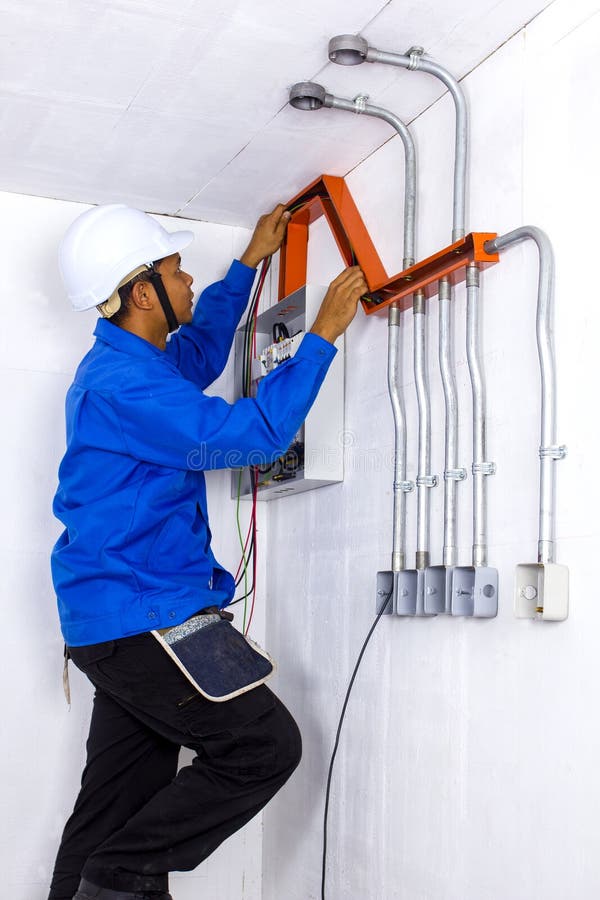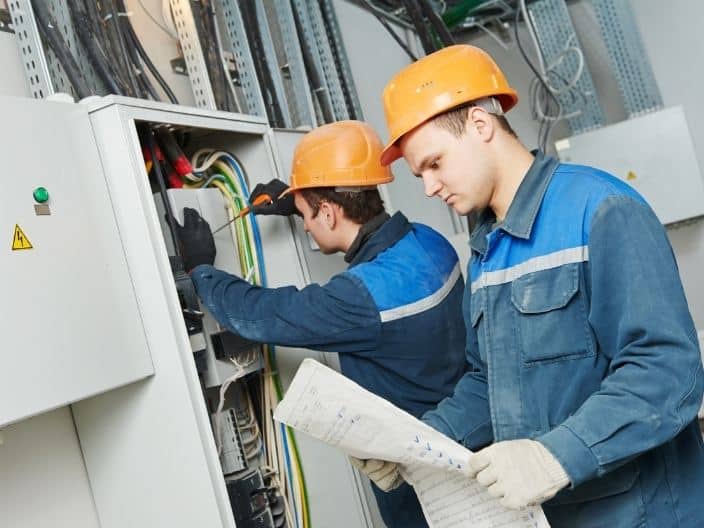Wiremen install and maintain electrical wiring systems. They ensure safe and efficient electrical connections.
Wiremen, also known as electricians, play a crucial role in modern infrastructure. They handle a wide range of tasks, from installing new wiring in buildings to troubleshooting and repairing existing electrical systems. Their work ensures that homes, offices, and industrial facilities have reliable and safe electrical power.
Wiremen must possess strong technical skills and adhere to strict safety standards to prevent electrical hazards. They often work with blueprints and technical diagrams to install wiring according to specifications. This profession requires both physical stamina and attention to detail, making it essential for the seamless operation of our daily lives and the functioning of various industries.

Credit: www.dreamstime.com
Introduction To Wireman
A Wireman is a skilled professional responsible for installing and maintaining electrical systems. They play a vital role in ensuring safe and efficient electricity flow in homes and businesses. Let’s explore their role, responsibilities, and their importance in modern homes.
Role And Responsibilities
Wiremen handle various tasks related to electrical systems. Their primary duties include:
- Installing electrical wiring
- Maintaining existing electrical systems
- Repairing faulty wiring
- Ensuring compliance with safety codes
- Reading and interpreting blueprints
They also work closely with architects and engineers. This ensures that electrical systems are integrated seamlessly into building designs.
Importance In Modern Homes
Wiremen are crucial for modern homes. They ensure that all electrical devices function properly. Without their expertise, homes would face frequent electrical issues.
Key reasons for their importance:
- Safety: Proper wiring prevents electrical hazards.
- Efficiency: Well-installed systems reduce energy consumption.
- Reliability: Regular maintenance minimizes downtime.
Wiremen also contribute to smart home integrations. They install systems that allow remote control of lights and appliances. This makes homes more convenient and energy-efficient.
| Task | Importance |
|---|---|
| Installing wiring | Ensures electrical flow |
| Maintaining systems | Prevents issues |
| Repairing faults | Fixes problems quickly |
Essential Tools And Equipment
Every wireman needs the right tools and equipment to do the job. These tools help ensure efficiency and safety. This section details the basic hand tools and advanced electrical tools every wireman should have.
Basic Hand Tools
Basic hand tools are a wireman’s best friends. They are essential for everyday tasks.
- Screwdrivers: Both flathead and Phillips are necessary. They help tighten and loosen screws.
- Pliers: Needle-nose and lineman’s pliers are essential. They grip, twist, and cut wires.
- Wire Strippers: These remove insulation from wires. They come in various sizes.
- Tape Measure: Accurate measurements are crucial. A tape measure ensures precision.
Advanced Electrical Tools
Advanced tools are needed for complex tasks. They provide accuracy and safety.
| Tool | Purpose |
|---|---|
| Multimeter | This measures voltage, current, and resistance. It helps in diagnosing issues. |
| Voltage Tester | Used to check if a wire is live. It ensures safety during work. |
| Crimping Tool | This tool is used for crimping connectors onto wires. It ensures a secure connection. |
| Fish Tape | Used to route new wiring through walls and electrical conduit. It is flexible and strong. |
These advanced tools are vital for a wireman’s toolkit. They help complete complex electrical tasks efficiently.
Understanding Electrical Systems
Electrical systems power our homes, offices, and industries. A wireman ensures these systems work efficiently and safely. Understanding the basics of electrical systems is crucial for anyone interested in this field.
Types Of Wiring
Different projects require different types of wiring. Here are the main types:
- Cleat Wiring: Uses PVC or VIR insulated wires. These wires run on walls or ceilings.
- Casing and Capping Wiring: Wires are enclosed in a wooden casing.
- Batten Wiring: Uses insulated wires fixed on wooden battens.
- Conduit Wiring: Wires run through PVC or metal pipes.
Components Of An Electrical Circuit
An electrical circuit consists of several components. Each part plays a vital role. Here are the main components:
| Component | Description |
|---|---|
| Power Source | Provides the electrical energy. Examples: batteries, generators. |
| Conductors | Carry the electrical current. Usually made of copper or aluminum. |
| Load | Uses the electrical energy. Examples: lights, appliances. |
| Switch | Controls the flow of electricity. Turns the circuit on or off. |
| Fuse | Protects the circuit from overcurrent. Melts to break the circuit. |
Understanding these components helps in troubleshooting and designing circuits.
Safety Precautions
Working as a wireman involves handling electrical systems. It’s crucial to follow safety precautions. Safety ensures not only your well-being but also the efficiency of your work.
Personal Protective Equipment
Personal Protective Equipment (PPE) is vital for wiremen. Wearing the right gear can prevent accidents. Here are essential PPE items:
- Insulated Gloves: Protects from electric shocks.
- Safety Goggles: Shields eyes from sparks and debris.
- Hard Hat: Protects head from falling objects.
- Non-conductive Boots: Prevents grounding.
Safe Work Practices
Following safe work practices is crucial. These practices ensure a safe environment. Here are some key practices:
- Turn Off Power: Always switch off power before starting work.
- Use Proper Tools: Only use tools designed for electrical work.
- Check for Damages: Inspect wires and tools for any damage.
- Stay Dry: Avoid working in wet conditions.
| Safety Precaution | Importance |
|---|---|
| Insulated Gloves | Prevents electric shocks |
| Safety Goggles | Protects eyes from debris |
| Turn Off Power | Avoids electrical accidents |
| Use Proper Tools | Ensures safety and efficiency |
Installation Techniques
Installing electrical systems requires precision and skill. Learning the best installation techniques can ensure safety and efficiency. Below we dive into the essential steps for a successful installation.
Planning And Layout
The first step is planning. Create a detailed layout of the installation area. This includes:
- Identifying all outlets and switches.
- Marking the positions of electrical boxes.
- Charting the path for wiring.
Use a floor plan for accuracy. This helps in visualizing the entire system. It’s crucial to plan the wire routes to avoid obstacles.
Safety Tip: Ensure all power sources are turned off before starting.
Step-by-step Installation
Follow these steps for a smooth installation process:
- Mount Electrical Boxes: Secure boxes at marked positions.
- Run the Cables: Use fish tape to guide cables through walls.
- Strip the Wires: Remove insulation to expose the wire ends.
- Connect Wires: Match the wires by color and connect them.
- Install Switches and Outlets: Attach devices to the electrical boxes.
- Test the System: Turn on the power and use a tester to check connections.
Pro Tip: Label each wire to avoid confusion during connections.
By following these steps and techniques, you can ensure a successful wireman installation. Always prioritize safety and double-check your work.
Troubleshooting Common Issues
Wiremen often face various challenges while on the job. Some problems are common and easy to fix. This section covers troubleshooting common issues. The focus is on identifying problems and finding effective solutions.
Identifying Problems
Identifying problems quickly is crucial. Here are some common issues:
- Short Circuits: These occur when wires touch each other.
- Loose Connections: Over time, screws and wires can loosen.
- Overloaded Circuits: Too many devices on one circuit can cause overload.
- Faulty Outlets: Outlets wear out and may stop working.
- Tripped Breakers: Breakers trip when circuits are overloaded.
Effective Solutions
Effective solutions help resolve problems efficiently. Here are some methods:
- Inspect Wires: Check for frayed or damaged wires. Replace if necessary.
- Tighten Connections: Use a screwdriver to tighten loose screws.
- Redistribute Load: Spread out devices across multiple circuits.
- Replace Outlets: Swap faulty outlets with new ones.
- Reset Breakers: Flip the breaker switch to reset it.
| Problem | Solution |
|---|---|
| Short Circuits | Inspect and separate wires. |
| Loose Connections | Tighten all screws and connections. |
| Overloaded Circuits | Redistribute devices across circuits. |
| Faulty Outlets | Replace old outlets. |
| Tripped Breakers | Reset the breaker switch. |
Upgrading Electrical Systems
Upgrading electrical systems can enhance safety and efficiency. It is crucial for older homes and businesses. Newer systems support modern appliances and technology.
Modernization Benefits
Upgrading offers many benefits. Below is a list of key advantages:
- Improved Safety: Modern systems reduce fire risks.
- Energy Efficiency: New systems save on electricity bills.
- Increased Capacity: Handle more devices and appliances.
- Smart Technology: Integrate with smart home devices.
Steps To Upgrade
Follow these steps to upgrade your electrical system:
- Assessment: Hire a licensed wireman to inspect your system.
- Planning: Plan the upgrade based on your needs.
- Permits: Secure necessary permits from local authorities.
- Installation: Replace old wires and panels with new ones.
- Inspection: Get a final inspection to ensure everything is safe.
Upgrading electrical systems is a wise investment. It ensures safety and efficiency for years to come.

Credit: www.etasv.org
Regulations And Standards
Being a wireman requires strict adherence to various regulations and standards. These rules ensure safety and quality in electrical installations. Understanding these standards is crucial for every wireman. Below, we explore key regulations and industry best practices.
Local Building Codes
Each region has local building codes that wiremen must follow. These codes ensure safe electrical installations. They cover aspects like wiring methods, material quality, and safety protocols.
Local building codes can vary by city or state. Wiremen must stay updated with the latest changes. Here are some common elements found in local building codes:
- Approved wiring methods
- Proper grounding techniques
- Installation of circuit breakers
- Fire safety measures
Familiarity with these codes helps wiremen avoid legal issues. It also ensures safe and compliant electrical work.
Industry Best Practices
Beyond local codes, wiremen should follow industry best practices. These practices improve the quality and safety of electrical installations. They are widely accepted within the profession.
Here are some key industry best practices:
- Regularly inspect tools and equipment
- Use personal protective equipment (PPE)
- Label all electrical panels and circuits
- Conduct routine safety audits
Following these best practices promotes a culture of safety. It also enhances the reliability of electrical systems. Staying informed about industry best practices is essential for professional growth.

Credit: csaew.com
Frequently Asked Questions
What Does A Wireman Do?
A wireman installs and maintains electrical wiring systems. They work in residential, commercial, and industrial settings. Their tasks include installing wires, circuit breakers, and other electrical components.
How Do You Become A Wireman?
To become a wireman, complete a high school diploma and an apprenticeship program. Many wiremen also obtain certification or licensure depending on local regulations.
What Skills Does A Wireman Need?
A wireman needs strong problem-solving skills and attention to detail. They should be able to read blueprints and understand safety protocols.
How Much Does A Wireman Earn?
Wireman salaries vary by location and experience. On average, they earn between $40,000 to $70,000 annually. Certification can increase earnings.
Conclusion
Choosing a skilled wireman ensures safety and efficiency in electrical work. Their expertise prevents potential hazards and costly repairs. Trust in a professional wireman for your electrical needs. Quality workmanship and peace of mind are invaluable. Make the right choice for your home or business today.




